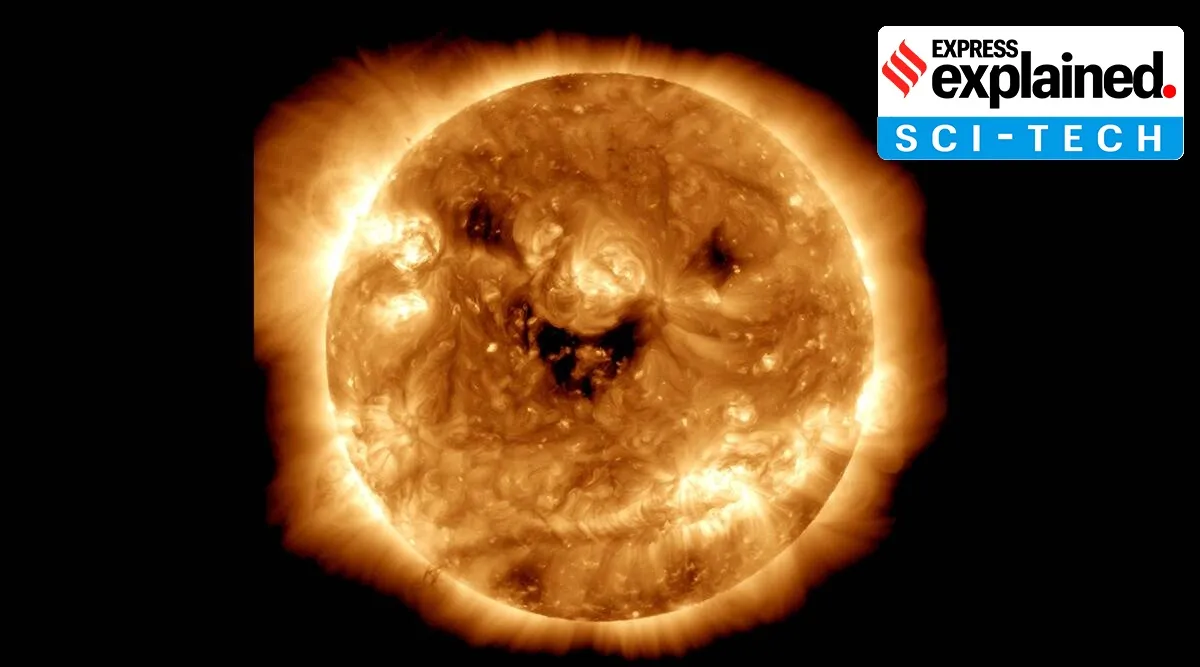CORONAL HOLES
- There are regions on the Sun's surface from where fast solar wind gushes out into space.
- As they contain little solar material, they have lower temperatures & thus appear darker than their surroundings.
- Here, the magnetic field is open to interplanetary space, sending solar material out in a high-speed stream of solar wind.
- Coronal holes can last between a few weeks to months, appearing throughout the Sun's approximately 11-year solar cycle.
- The coronal holes are important to understanding the space environment around the Earth through which the technology & astronauts travel.
- Coronal holes cover 6-8% of the total solar surface.
- The reasons for coronal holes are unknown.
- Scientists study these fast solar wind streams because they sometimes interact with Earth's magnetic field, creating a geomagnetic storm, which can expose satellites to radiation & interfere with communications signals.

- As per the US National Oceanic & Atmospheric Administration (NOAA), geomagnetic storms relate to Earth's magnetosphere.
- Magnetosphere is the space around a planet influenced by its magnetic field.
- When a high-speed solar stream arrives at Earth, it can allow energetic solar wind particles to hit the atmosphere over the poles.
- In the case of the strong solar wind, the resulting geomagnetic storm can cause changes in the ionosphere, part of the Earth's upper atmosphere.
- Radio & GPS signals travel through this layer, so communications can get disrupted.
Solar maximum and solar minimum are two phases of the solar cycle, which is an approximately 11-year period characterized by changes in the Sun's activity.
Solar Maximum: This is the phase of the solar cycle when solar activity is at its highest. During solar maximum, there is an increase in the number of sunspots on the Sun's surface, as well as solar flares and coronal mass ejections (CMEs). The Sun's magnetic activity is more pronounced, leading to these phenomena. Solar maximum can cause disruptions in satellite communications, power grids, and can also increase the visibility of auroras in regions closer to the poles.
Solar Minimum: This is the phase when solar activity is at its lowest. Sunspots are less frequent or even absent during this time. The Sun's magnetic activity is quieter, and there are fewer solar flares and CMEs. Solar minimum is associated with a decrease in the overall solar output. While it might seem less eventful, it's an important phase as it marks the beginning of the next solar cycle.
These cycles are part of the Sun's natural variability, and studying them helps scientists understand solar phenomena and their potential impacts on Earth's environment and technology
6.What is the solar cycle?
- The solar cycle refers to the approximately 11-year cycle of changes in the Sun's activity. It's characterized by a periodic variation in the number of sunspots, as well as other solar phenomena such as solar flares, coronal mass ejections (CMEs), and changes in the Sun's magnetic field.
- The cycle starts at solar minimum when solar activity is at its lowest, with fewer sunspots and reduced solar flares and CMEs. Over the course of about 11 years, solar activity gradually increases, reaching a peak known as solar maximum. During solar maximum, there's a higher occurrence of sunspots, intense solar flares, and more frequent CMEs.
- After reaching its peak, solar activity decreases again, entering another solar minimum, and the cycle starts anew. This cyclic variation in solar activity is driven by the Sun's magnetic field and the dynamo processes occurring within it.
- Scientists study the solar cycle to better understand the Sun's behavior and its impact on space weather, Earth's atmosphere, climate, and technological systems. The solar cycle has implications for satellite communications, power grids, and even the Earth's climate patterns.




